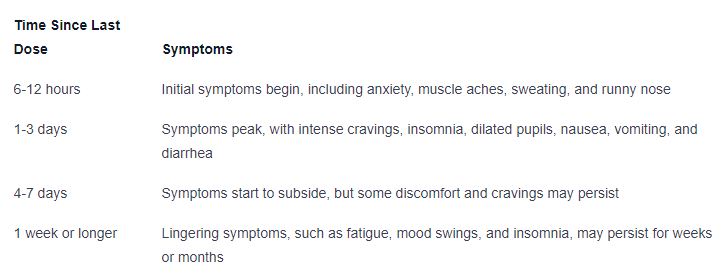Heroin Withdrawal Symptoms, Timeline and Heroin Detox Centers

Understanding Heroin Withdrawal
When an individual stops using heroin after a period of regular use, they may experience a range of withdrawal symptoms. Understanding these symptoms and the timeline of heroin withdrawal is crucial for individuals seeking recovery and the healthcare professionals supporting them.
Symptoms of Heroin Withdrawal
Heroin withdrawal symptoms typically begin within 6-12 hours after the last dose and peak between 1-3 days. The severity and duration of symptoms can vary depending on several factors, including the individual's level of dependence and overall health.
Common symptoms of heroin withdrawal include:
- Anxiety
- Muscle aches
- Sweating
- Runny nose
- Excessive yawning
- Insomnia
- Dilated pupils
- Nausea
- Vomiting
- Diarrhea
These symptoms can be distressing and uncomfortable, but they are not typically life-threatening. However, in some cases, severe dehydration or complications arising from vomiting and diarrhea may require medical attention.
Timeline of Heroin Withdrawal
The timeline for heroin withdrawal can vary from person to person, but it generally follows a similar pattern. Withdrawal symptoms typically start within 6-12 hours of the last heroin dose and peak around day 2 or 3. The symptoms can last for about a week, with some individuals experiencing lingering symptoms for weeks or even months.
Here is a general timeline of heroin withdrawal:

It's important to note that the severity and duration of withdrawal symptoms can vary for each individual. Some individuals may experience a more prolonged withdrawal period, while others may have a shorter and less intense experience.
Managing heroin withdrawal often requires professional support, and medications such as methadone, buprenorphine, and naltrexone may be used to help manage withdrawal symptoms and reduce cravings. Seeking medical assistance and guidance from healthcare professionals is crucial for a safe and effective journey through heroin withdrawal.
Detoxification and Treatment Options
When it comes to heroin withdrawal, there are various detoxification and treatment options available to individuals seeking help. Two key components of the process include the use of medications for managing withdrawal symptoms and the selection of an appropriate heroin detox center.
Medications for Heroin Withdrawal
Medications play a crucial role in helping individuals manage the symptoms of heroin withdrawal and reduce cravings. Commonly used medications include methadone, buprenorphine, and naltrexone. These medications can help alleviate withdrawal symptoms, such as nausea, muscle aches, and anxiety, allowing individuals to navigate the detoxification process more comfortably.

Choosing a Heroin Detox Center
Selecting the right heroin detox center is crucial for a safe and successful withdrawal process. Detox centers provide medical supervision and support to individuals undergoing detoxification, ensuring a safe environment to manage withdrawal symptoms and begin the journey to recovery.
When choosing a detox center, several factors should be considered:
- Staff qualifications: It is important to ensure that the staff members at the detox center are qualified professionals with expertise in addiction treatment.
- Treatment approach: Different detox centers may have varying treatment approaches. It is essential to find a center that aligns with the individual's specific needs and preferences.
- Client reviews: Reading reviews and testimonials from previous clients can provide insight into the quality of care and effectiveness of the detox center.
- Amenities: Some detox centers may offer additional amenities and services, such as comfortable accommodations, recreational activities, and holistic therapies. Consider what amenities are important to you.
- Aftercare options: A comprehensive detox program should include plans for ongoing treatment and support after the withdrawal process. Look for a detox center that provides appropriate aftercare resources.
By carefully considering these factors, individuals can make an informed decision when choosing a heroin detox center that best suits their needs and increases the likelihood of a successful recovery journey.
Detoxification and treatment options for heroin withdrawal are essential steps in overcoming heroin addiction. With the help of medication-assisted treatment and the support of a reputable detox center, individuals can navigate the challenging withdrawal process and move towards a healthier, drug-free life.
Seeking Help for Heroin Addiction
When dealing with heroin addiction, it is crucial to seek help from professionals who can provide guidance and support throughout the recovery process. There are various resources available for individuals struggling with heroin addiction, including helplines and information on heroin detox centers.
National Helpline for Substance Abuse
The Substance Abuse and Mental Health Services Administration (SAMHSA) provides a national helpline for individuals seeking help with substance abuse and mental health issues. In times of crisis, the helpline can be reached by calling or texting 988. Trained professionals are available 24/7 to offer confidential assistance, information, and referrals to local resources.
Resources for Heroin Detox Centers
If you or someone you know needs help with heroin use or overdose prevention, there are various resources and services available in Canada. Health Canada provides information on hotlines, text lines, online support groups, harm reduction centers, and provincial health services for individuals seeking help with heroin addiction.
SAMHSA's national helpline can also provide information on local heroin detox centers, treatment options, and support services for individuals seeking help for heroin addiction. Utilizing these resources can help individuals connect with professionals who specialize in addiction treatment and recovery.
Remember, seeking help is an important step towards overcoming heroin addiction. Whether it is through helplines, detox centers, or other support services, reaching out for assistance can provide the guidance and support needed to start the journey towards recovery.
Opioid Use Disorder (OUD) Treatment
Opioid Use Disorder (OUD) is a significant public health concern, affecting millions of individuals worldwide. OUD encompasses a range of conditions, from opioid dependence to addiction. Common symptoms include an intense desire to use opioids, increased tolerance to opioids, and withdrawal syndrome upon discontinuation of opioids.
Overview of Opioid Use Disorder
Opioid Use Disorder is a complex condition that requires comprehensive treatment. Successful management of OUD involves a combination of approaches, including medication-assisted treatment (MAT), cognitive-behavioral therapy, and an interprofessional healthcare team. The primary goal of treatment is to improve patient outcomes by reducing drug relapses, criminal behavior, and mortality rates.
Medication-Assisted Treatment (MAT) Options
Medication-Assisted Treatment (MAT) is a highly effective approach for managing Opioid Use Disorder. MAT combines the use of medications with counseling and behavioral therapies to address the physical and psychological aspects of addiction. Medications used in MAT help to stabilize brain chemistry, reduce cravings, and alleviate withdrawal symptoms.
Methadone
Methadone is a long-acting opioid agonist that has been used for decades in the treatment of OUD. It is administered in specially monitored clinics and helps to prevent withdrawal symptoms and cravings. The use of methadone is strictly regulated to ensure patient safety and minimize the risk of diversion.
Buprenorphine
Buprenorphine is a partial opioid agonist that can be prescribed by qualified healthcare providers in a variety of settings, including office-based practices. The Mainstreaming Addiction Treatment (MAT) Act has expanded federal guidelines to increase access to buprenorphine treatment for OUD, removing the previous limitations of the DATA-Waiver (X-Waiver) program. Buprenorphine is available in different forms, such as sublingual tablets and films, and helps to reduce cravings and withdrawal symptoms.
Naltrexone
Naltrexone is an opioid antagonist that blocks the effects of opioids in the brain. It is used in patients who are free of physiological opioid dependence, as it does not alleviate withdrawal symptoms or cravings. Naltrexone can be administered orally or as a monthly injection, providing a non-addictive approach to OUD treatment.
When considering medication-assisted treatment options for OUD, it is essential to consult with a qualified healthcare professional who can assess individual needs and determine the most suitable treatment plan. The choice of medication may depend on factors such as the severity of OUD, patient preferences, and the presence of co-occurring mental health conditions.
By utilizing medication-assisted treatment options, individuals with Opioid Use Disorder can receive the support they need to overcome addiction and achieve long-term recovery. Combined with comprehensive therapy and a patient-centered approach, MAT can significantly improve the outcomes and quality of life for those affected by OUD.
Effective Methods for Heroin Withdrawal
When it comes to heroin withdrawal, there are several effective methods that can help individuals manage the symptoms and navigate the challenging process. Some of the most widely used methods include methadone substitution and tapering, buprenorphine for heroin withdrawal, and clonidine along with other supportive measures.
Methadone Substitution and Tapering
Methadone is considered one of the most effective withdrawal agents for heroin addiction. It works by substituting the heroin with a longer-acting opioid that helps to reduce withdrawal symptoms and cravings. However, it's important to note that methadone should be administered under the supervision of a healthcare professional due to its potential for misuse and overdose.
During methadone detoxification, the initial dose is typically kept below 40 mg to avoid potential complications. The dosage is then gradually reduced over a period of time. Inpatient methadone substitution and tapering usually take about 5 to 7 days, while outpatient detoxification may take longer. It's worth mentioning that clonidine, an α2-adrenergic agonist drug, can be used to manage lingering withdrawal symptoms that may persist even with methadone treatment.
Buprenorphine for Heroin Withdrawal
Another effective method for heroin withdrawal is the use of buprenorphine. This long-acting opioid medication can be administered sublingually and is considered safe for use in emergency department settings. The dosage of buprenorphine should be adjusted based on the patient's individual needs and comfort level. A slow taper over a week or so is generally a safe and well-tolerated strategy.
Buprenorphine can also be utilized to transition patients from methadone maintenance to buprenorphine maintenance or even a drug-free state. It's important to note that clonidine can be used in conjunction with buprenorphine to address any withdrawal symptoms that may not be fully suppressed by the medication.
Clonidine and Other Supportive Measures
Clonidine, an α2-adrenergic agonist drug, has been used for over 25 years to facilitate opioid withdrawal. It helps to reduce many of the autonomic components of the withdrawal syndrome. However, it may not fully address symptoms such as insomnia, lethargy, muscle aches, and restlessness. It's worth mentioning that clonidine has more side effects, such as hypotension, compared to methadone-aided withdrawal. An analogue of clonidine called lofexidine may be as effective for opioid withdrawal with less hypotension and sedation.
In addition to clonidine, other supportive measures can be employed to alleviate specific withdrawal symptoms. Medications for insomnia, muscle cramps or pain, diarrhea, nausea and vomiting, and flu-like symptoms can be utilized during the withdrawal period. These measures aim to provide comfort and support as individuals navigate the challenging process of heroin withdrawal [5].
By utilizing these effective methods for heroin withdrawal, individuals can receive the necessary support and care to manage the symptoms and work towards a healthier, drug-free life. It's important to seek professional guidance and support when undergoing heroin withdrawal to ensure safety and a successful recovery.
References
[1]: https://www.acadiavermilion.com/addiction/heroin/withdrawals-signs-symptoms/
[2]: https://www.samhsa.gov/find-help/national-helpline
[3]: https://www.canada.ca/en/health-canada/services/substance-use/get-help-with-substance-use.html
